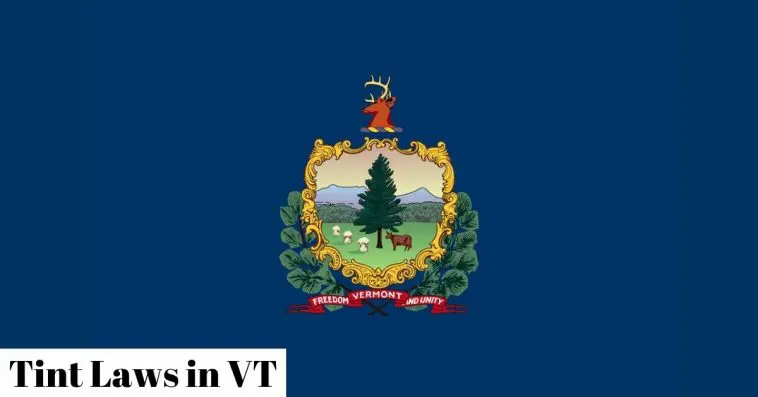The Vermont window tint laws were passed in 1984. To help drivers get an accurate image of the regulations and limitations in the state, I’ve listed all the relevant information that can come in handy.
Here, you will get a detailed overview of the window tinting basics, including practical ways to implement them. The laws compiled here are only meant for the Vermont state in the New England region of the U.S.
TABLE OF CONTENTS
Are You Allowed To Have Tinted Windshield And Windows In Vermont?
Yes. People can get access to tinted windows and windshields in Vermont. But with limits. They can use non-reflective tint that’s over the AS-1 line. However, they must follow the window tint laws to be permitted to use the film.
In this state, tinted front-passenger and driver windows are illegal. As well as tinted headlights, taillights, and plate covers. There is also a limit to how dark the windows can be.
Although tinting could be useful for skin protection and keep some of the items in the vehicle away from damage, it is critical to pay attention to these legal limits.
What Is The Darkest Tint You Can Legally Get In VT?
Each state has its own legal tint limit. Vermont tint laws are quite laid back when it comes to the rear and back windows. Any darkness level is permitted. The only real setback is the side windows. Typically, there is a tint limit of 35%.
VLT (Visible Light Transmission) is used to determine the percentage of the light that the film lets pass through the glass and into the car. The higher the VLT, the more light passes through the tint.
For instance, 75% of tint lets 75% of light pass. While 5% of tint only lets 5% of light pass. In other words, 5% tint uses the darkest film. This state has distinct allowable limits, which citizens are expected to abide by.
Is 20 Tint Illegal In VT?
20 tint is illegal in Vermont when it comes to front side windows. But, for the backside and rear windows, it shouldn’t be a problem. As long as you have dual side mirrors for the tinted windows in the back, you have nothing to worry about.
With the 20 tints, people have to get closer to the window to see through the glass from an outside perspective. However, it can be quite challenging. That’s why you would need to roll down the window every time you talk to a cop.
Can You Get Pulled Over For Tinted Windows In Vermont?
People can get pulled over for having a dark tint. But, it doesn’t always have to be the case. Some people have had 20% tint for a long time and never had any problems with it. They stick to the speed limit and never have a real issue.
While others end up drawing attention to themselves and get pulled over by a cop, if you break the Vermont window tint laws, you could get fined.
In most cases, cops stop drivers who do typical driving offenses. If, by any chance, they notice you have a darker tint, they could let you in on the legal limits.
How Much Is A Tint Ticket In VT?
It’s difficult to say. Typical fines in Vermont for law violations range anywhere from $47 to $1,197. Officers take into account how many times you’ve gotten yourself a tint ticket. For example, if it’s your first time getting fined, the pay tends to be minimal.
But, the more you get stopped, the larger the fines get. If you remove the tint as the cop is walking over to your vehicle, then you will get additional charges. Factors such as these will drastically affect the cost of the tint ticket.
Window Tint Darkness In Vermont
Tinting limits are everywhere. Vermont also has its own guidelines, laws, and limitations for those who want to darken a window.
These vary based on the type of vehicle, like a passenger or MPV. Getting acquainted with these rules is an important step in avoiding tickets.
Here are a couple of tint laws you should know about. All the information listed here is categorized for easy viewing.
For Passenger Vehicle
- Windshield: Drivers can use a non-reflective tint that’s above the AS-1 line.
- Front Side Windows: Applying a tint to these windows is illegal.
- Back Side Windows: Drivers can use any darkness of their choosing.
- Rear Window: Drivers can use any darkness of their choosing.
For MPV (Multi-Purpose Vehicle)
- Windshield: Drivers can use a non-reflective tint that’s above the AS-1 line.
- Front Side Windows: Applying a tint to these windows is illegal.
- Back Side Windows: Drivers can use any darkness of their choosing.
- Rear Window: Drivers can use any darkness of their choosing.
Window Tint Reflection In Vermont
Tinting restrictions in Vermont are also critical. The state allows a specific type of reflection to be used when tinting the window. Following these guidelines can help people avoid a future ticket.
Here is how these restrictions look like according to the vehicle used.
For Passenger Vehicle
- Front Side Window: No metallic/mirrored reflection appearance can be applied.
- Back Side Window: No metallic/mirrored reflection appearance can be applied.
For MPV (Multi-Purpose Vehicle)
- Front Side Window: No metallic/mirrored reflection appearance can be applied.
- Back Side Window: No metallic/mirrored reflection appearance can be applied.
How Do You Get A Medical Exemption For Window Tint In Vermont?
The Vermont Department of Motor Vehicles can provide a suitable Vehicle Stability Assist (VSA) for individuals who need a darker tint for medical reasons. The exemption can be used for both the driver or the regular passenger in that vehicle.
To apply for an exemption, your doctor will need to certify you or your passenger as a medical necessity. You will then receive a 4-year permit that you have to carry around with you in case of inspection.
Conclusion
That’s about it. Do have in mind that some of the tinting restrictions might be different in the county you live in.
It would be in your best interest to double-check the laws with your local law enforcement authority or the Vermont Department of Motor Vehicles.




